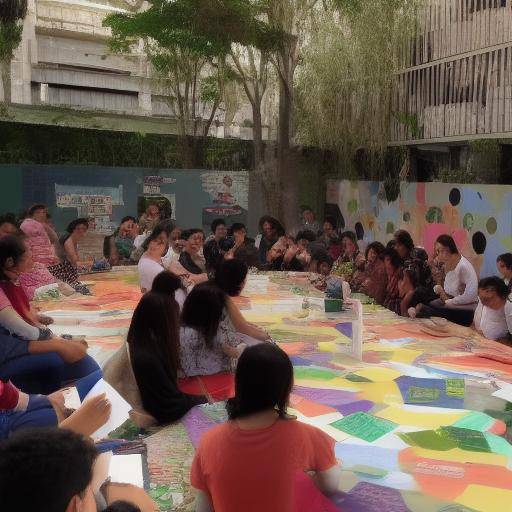
Introduction
Currently, design skills have become a crucial element in various fields and disciplines. From graphic design to architecture and engineering, the ability to think creatively, solve problems and communicate visually is fundamental to success in the modern world. In this article, we will explore the importance of teaching design skills in the classroom, highlighting its current benefits, challenges and trends.
History and Background
The origin of design skills teaching dates back to the Industrial Revolution, when the need to train professionals capable of managing the new machinery and developing innovative solutions prompted the emergence of industrial design and architecture programs. Over time, it has become a key component of contemporary education, addressing not only technical but also creative and conceptual aspects.
The emergence of computer and digital technologies has revolutionized the field of design, providing new tools and approaches. This has led to substantial evolution in the way design skills are taught, incorporating more agile, interactive methodologies and focused on solving problems with multidisciplinary approaches.
Analysis in Deep
Teaching design skills in the classroom offers a wide range of benefits for students. In addition to fostering creativity and lateral thinking, design provides a platform to address complex challenges, encourage experimentation and promote interdisciplinary collaboration.
Despite their benefits, there are significant challenges in teaching design skills. The evaluation of project-based learning and the availability of adequate resources are aspects to be considered. In turn, current trends highlight the importance of integrating principles of sustainability, accessibility and diversity in design teaching, as well as the use of digital tools and platforms.
Comprehensive review
The application of design skills in the classroom has been proven effective in a variety of contexts, from the design of architectural projects to the creation of user interfaces. Through the comparative analysis of different pedagogical approaches, it has been shown that the integration of theory with practice offers optimal results.
The collection of experts' perspectives reveals that the teaching of classroom design skills will continue to evolve, with a growing emphasis on training for remote work, project management and user-centred design, among other aspects. In addition, greater emphasis is placed on the incorporation of emerging technologies, such as virtual reality and artificial intelligence, to enrich the educational experience.
Practical Tips and Accessible Tips
In teaching classroom design skills, it is essential to foster an environment that encourages active participation, critical thinking and student autonomy. This can be achieved through active methodologies, such as project-based learning, individualized mentoring and the use of online learning platforms that offer collaborative and feedback tools.
Industry Perspectives and Expert Reviews
The perspectives of industry and the opinions of experts in the field of educational design highlight the need to focus on the development of interdisciplinary skills, the integration of ethics and social responsibility in design, and the agile adaptation to technological and cultural changes in the field of work.
Case Studies and Real Life Applications
Case studies showing practical applications of design skills in the educational and professional field demonstrate the positive influence that these skills have on solving problems, innovation and effective communication. From sustainable urban design projects to brand design campaigns, these examples illustrate how learning design skills in the classroom translates into tangible and relevant solutions for society.
Future Trends and Predictions
The future of teaching design skills in the classroom is profiling towards greater integration of active methodologies and emerging technologies. Gamification, increased reality and artificial intelligence are expected to play significant roles in the way design skills are taught and applied in the future. Adaptation to hybrid learning environments also becomes a priority, given the impact of globalization and digitalization on education.
Conclusion
In short, teaching design skills in the classroom represents an invaluable opportunity to prepare students for the challenges and opportunities of the contemporary world. In fostering creativity, critical thinking and problem solving, the formation of individuals capable of promoting innovation and sustainable development in various areas is enhanced. The integration of design skills in the educational curriculum continues to be a promising path towards the formation of competent and visionary professionals.
FAQs
**1. What are the main design skills that can be taught in the classroom?**Design skills include aspects such as creative thinking, digital design tools management, conceptualization and visual communication, and problem solving through design.
**2. How can you integrate design skills teaching into different subjects?**The integration of the teaching of design skills in subjects such as mathematics, science, and language can be achieved through interdisciplinary projects that raise challenges that require creative and visually communicative solutions.
**3. What are the most used technological tools and resources to teach design skills in the classroom?**Graphic design tools such as Adobe Photoshop and Illustrator, 3D modeling software such as AutoCAD and SketchUp, as well as online collaborative platforms, are widely used to teach design skills.
**4. What role does evaluation play in teaching design skills in the classroom?**Project-based learning assessment, portfolio presentation and continuous feedback are common approaches to assessing student design skills development.
**5. How can teachers train to effectively teach design skills?**Teachers can be trained by participating in workshops and updating programs in educational design, as well as by exploring online resources and establishing professional networks with other design educators.
**6. What is the importance of user-centred design in teaching classroom design skills?**The user-centred design emphasizes the importance of understanding the needs and experiences of users by creating design solutions, thus promoting empathy and adaptability in students.
This article provides an integral insight into the teaching of design skills in the classroom, providing detailed information and practical perspectives for educators, students and professionals interested in this constantly evolving field.






















































